Yes, we are at an even dozen orders for ‘Glass Scamps! Thank you all for your patience… “our” Scamp will be well worth waiting for.
The mold for the interior (including floor, seats, water ballast tank, floor storage tank, sump, and seat hatch recesses) is laminated and undergoing final sanding a polishing. Likewise the bulkhead mold is built, and floor hatch molds are complete. The latter parts will need final surface prep too, after we finish polishing the interior mold. Polishing rough molds takes (impart valley girl accent here)… “Foreeever!”
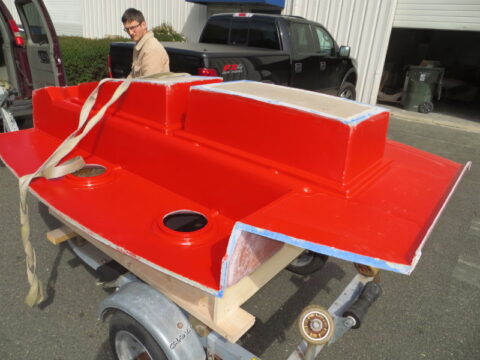
Loading the mold onto a trailer for transport from the Tacoma glass shop to Gig Harbor finishing shop.
See how shiny the mold looks in this picture? Well, it’s really not shiny at all. It has some residual mold release wax making it appear shiny but buried under the wax are myriad tiny pits and hairline scratches. You would see every one of those imperfections in a finished boat so here we go again, sanding interminably to get that true mirror finish. 380 grit, then 400 grit, then 600 grit, then wet or dry 600, then several types of polishing compound, then wax. The interior mold is particularly time consuming because the many tight inside corners and restricted areas can’t be tackled with machine sanders or polishers. All by hand. No fingerprints left when this is done!
The above two photos show something you haven’t seen yet; the areas outlined on the seat tops and floor are molded in nonskid. This is a nice, pebbled grain that will furnish security yet won’t be abrasive to tender backsides.
Those of you who have been around a bit longer than others will recognize ‘Tug” Tuggle in this photo. We called him back to help us with his Air Force expertise in fairing and polishing fiberglass. Thanks Tug! Having him here will save a week or so and reduce the anxiety factor!
During this time we have also been working on the centerboard and rudder. Good news here, we should have the first real genuine centerboard finished next week. Once that is in hand we can build the plug and mold for the centerboard trunk… and that’s the last major item before we can assemble an actual, real Fiberglass Scamp!
Other items of interest; Just a few days ago I ordered a quantity of 2 ¾” diameter 6061 aircraft aluminum tubing for our masts. This will be sent directly to the powder coat shop for the ‘Coffee Tan’ topcoat color. If you are not familiar with powder coating, this is much harder and more durable than paint. The finish starts as a powder that is electrostatically attracted to the aluminum; the coated tube is then heated in an oven to 400 degrees where the powder liquefies and bonds to the metal. Good stuff.
I’m in the last throes of decision about the material for yards and booms. Aluminum is easy and predictable, but after analysis I’m rethinking wood spars; homebuilt plans call for round wood spars which are very laborious and expensive to construct so are not a con sideration at our current price point. However, most of us agree that wood is aesthetically superior. So after a bit of gentle prodding, John Welsford sent us scantlings for rectangular wood spars with the same flex as aluminum or round wood spars. Round wood spars would be cost prohibitive but rectangular wood spars are quite practical. Chime in here if you have an opinion! Wood or Aluminum Yard and Boom?
The next update will detail plenty of appearance and operational items (prices too) to keep you up at night pondering how to personalize your Scamp.
Cheers,
Dave and Crew at GHBW
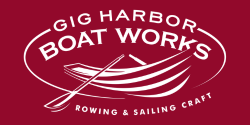
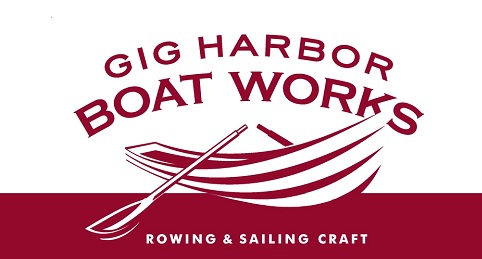

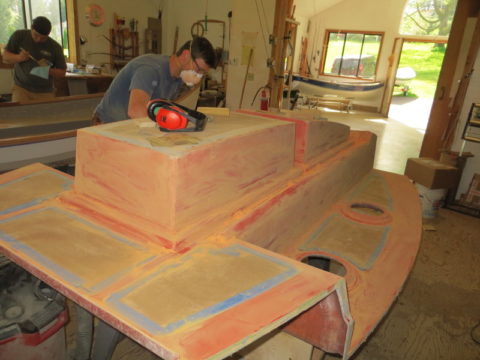

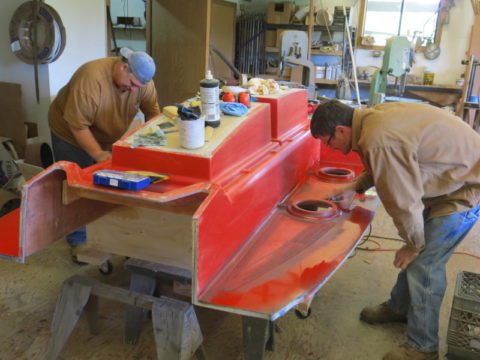
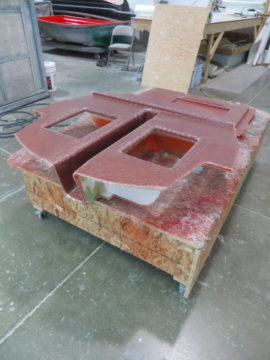
I’d go with wood. It’s easier to repair or replace if something happens. In addtion besides some light sanding every couple years it’s easier to maintain.
Plus if owners decide to move the running rigging, it’s easier to drill and mount stuff.
And lastly it just looks better!
I’d prefer aluminum. I would be concerned about strength and longevity of wood. Wood is essentially a composite – cellulose fibers bonded by lignin. When it fails, it fails catastrophically – it cracks, because it has no ductility. Aluminum, as opposed to wood, is ductile rather than brittle, it bends before it breaks. It also does not rot. Granted, it’s harder to work with when it comes to customizing,, but not by much. IMHO, aluminum is better.
I would opt for aluminum parts over wood myself for the same reasons as Ilya stated above in their post. I’m sure it would be simple enough to powder coat the rest of the aluminum parts when the masts are getting done, so as to have the parts for each boat in production. When it’s time for me to order my Scamp I’ll be requesting this. Thanks for building Scamps for those of us who can’t.